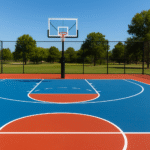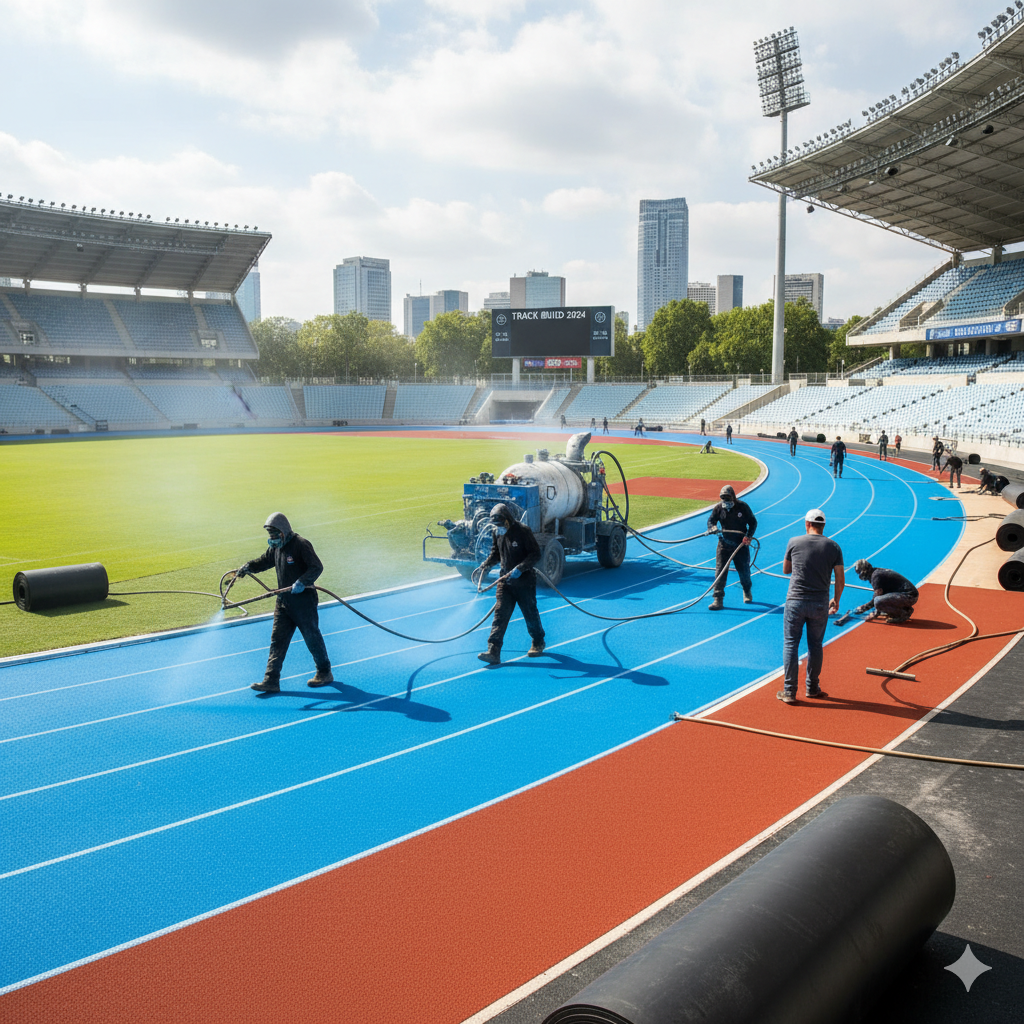Introduction
Have you ever wondered why professional sports tracks maintain consistent performance and durability across different stadiums? One of the most cost-effective and widely used solutions for athletic tracks is the spray coating running track. Unlike multi-layer systems, spray coating provides a uniform, weather-resistant surface that is ideal for schools, colleges, universities, and community sports arenas.
Spray coating tracks are designed not only for aesthetics but also for safety, comfort, and performance, making them an excellent choice for athletic training and local competitions.
What is a Spray Coating Running Track?
A spray coating running track is a single-layer or dual-layer synthetic track system applied directly on top of a prepared base, usually made of asphalt or concrete. The surface is created by spraying a mixture of polyurethane and colored granules onto the base, forming a seamless, non-slip, and weather-resistant layer.
This type of track is highly versatile and cost-effective, making it suitable for facilities with budget constraints or medium-level competitive requirements.
Dimensions of a Spray Coating Running Track
Spray coating tracks can be constructed to match Olympic or standard running track dimensions:
-
Total Length: 400 meters (for full tracks)
-
Number of Lanes: 6–8 lanes depending on available space
-
Lane Width: 1.22 meters per lane
-
Total Area: Depends on track layout; generally similar to standard Olympic tracks
Even with a spray coating system, accurate lane width and marking are crucial to ensure fairness and compliance with sports regulations.
Track Layout and Markings
The layout for spray coating tracks follows standard straight and curve combinations:
-
Straights: Typically 84–85 meters
-
Curves: Semicircular bends of around 115 meters each
-
Markings: Staggered start lines and lane indicators applied using durable paint
Proper line marking is essential to maintain international or national competition standards.
Materials Used in Spray Coating Tracks
Spray coating tracks are made from a combination of polyurethane binder and rubber granules:
-
Polyurethane: Provides binding, durability, and flexibility.
-
EPDM or SBR Granules: Offer shock absorption, slip resistance, and cushioning.
-
Optional Pigments: Add color and UV resistance for long-lasting appearance.
This material combination ensures a smooth, safe, and resilient track surface suitable for training and medium-level competitions.
Construction Process
Building a spray coating track involves several key steps:
-
Site Preparation: Select a level, well-drained area and inspect the base for cracks.
-
Base Construction: Lay asphalt or concrete to create a solid foundation.
-
Primer Application: Apply a primer to improve adhesion between base and spray layer.
-
Spray Coating: Spray a mixture of polyurethane and granules evenly over the surface.
-
Curing and Finishing: Allow the track to cure; apply lane markings and optional logos.
Each step must be executed with precision to ensure even surface texture and longevity.
Benefits of Spray Coating Tracks
-
Cost-Effective: Lower construction costs compared to multi-layered systems.
-
Quick Installation: Faster to apply and ready for use sooner.
-
Weather-Resistant: Withstands sun, rain, and moderate temperature variations.
-
Safe and Comfortable: Provides moderate shock absorption for athletes.
-
Customizable: Can be colored and designed according to facility needs.
Cost of Spray Coating Track Construction
The cost varies based on track size, material quality, and labor:
-
Average Cost in India: ₹1.2 – ₹2 crore for a full 400-meter track.
-
Global Costs: $150,000 – $300,000 depending on materials and location.
Spray coating tracks are an excellent choice for budget-friendly yet professional-grade surfaces.
Why Hire Professional Spray Coating Services?
Professional installation ensures:
-
Uniform surface and proper thickness.
-
Durable adhesion to the base for long-lasting performance.
-
Accurate lane widths and marking according to standards.
-
Compliance with safety and performance requirements.
Cutting corners on installation can lead to uneven surfaces, cracking, and reduced lifespan.
Maintenance of Spray Coating Tracks
-
Clean debris and dust regularly.
-
Inspect for cracks or peeling and repair promptly.
-
Avoid heavy machinery or vehicles on the track.
-
Resurface after 5–7 years to maintain performance and appearance.
Regular maintenance ensures the track remains safe, smooth, and functional for years.
Challenges in Spray Coating Track Construction
-
Weather Sensitivity: Rain or extreme temperatures during installation can affect curing.
-
Budget Constraints: High-quality polyurethane and granules increase costs.
-
Base Quality: Uneven or damaged asphalt/concrete can reduce track lifespan.
Conclusion
Spray coating running tracks provide an affordable, safe, and professional surface for athletic training and medium-level competitions. While they may not replace multi-layer Olympic-standard tracks for international events, they are perfect for schools, colleges, and local sports complexes seeking a high-performance running surface.
Partnering with a certified running track manufacturer or professional court construction service ensures your spray coating track is durable, safe, and compliant with sports standards.https://www.sports-facility.in/index.php
FAQs
1. What is the ideal thickness of a spray coating track?
Typically 10–13 mm for a single-layer system, depending on granule size.
2. How long does a spray coating track last?
With proper maintenance, 8–10 years before resurfacing is required.
3. Can spray coating tracks be used for competitions?
Yes, for local and regional competitions; international-level events usually require multi-layer systems.
4. Is spray coating cost-effective?
Yes, significantly cheaper than sandwich or full polyurethane tracks, while providing safe and durable performance.
5. How long does it take to install?
Usually 4–6 weeks, depending on size and curing conditions.




